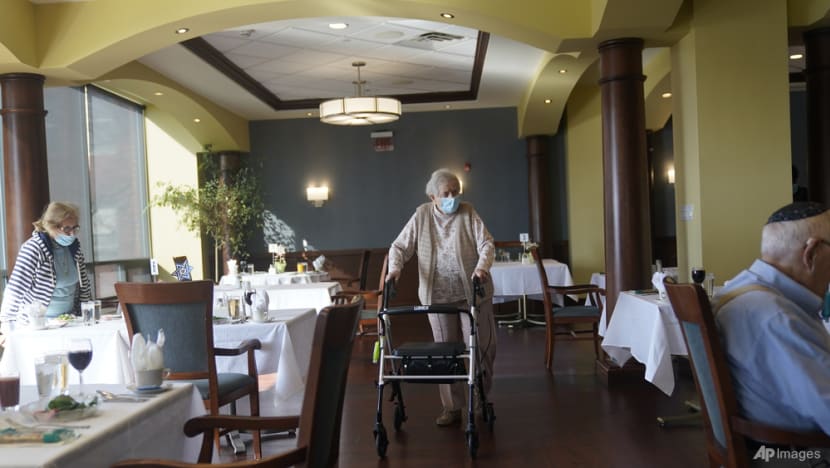Commentary: America’s indifference to its death crisis
The enduring drivers of the country’s morbid trajectory – rising obesity, the opioid epidemic and COVID-19 – are hard to confront, says the Financial Times’ Edward Luce.

WASHINGTON: Falling life expectancy is the last thing you would expect on a worry list about US national security. Yet when it is dropping as fast as it is in the US – Americans live almost five years less than the wealthy country average – even the Pentagon has to sit up.
At 76, Americans now live shorter lives than their peers in China and only a year longer than the citizens of supposedly benighted Mexico. People in Japan, Italy and Spain, on the other hand, can expect to live until around 84.
Your people’s longevity is the ultimate test of a system’s ability to deliver. Yet neither Democrats nor Republicans, presidents or legislators, seem too bothered.
Do Americans no longer care how long they live? The answer is obviously no. Yet concern about the country’s falling lifespan is barely reflected in its politics.
It is as though Washington has turned a blind eye to the issue that captures the deepest trends behind America’s democratic woes. Terms such as “deaths of despair” and “obesity epidemic” are in frequent use.
But America’s shortening lifespan seems too big a subject for Washington to acknowledge. US life expectancy has fallen in six of the last seven years and is now almost three years below what it was in 2014. The last time it fell in consecutive years was during the first world war. In most other democracies this would trigger a national debate.
TARGETING OBESITY HAS LITTLE POLITICAL UPSIDE
What explains US indifference? The biggest drivers of America’s morbid trajectory are politically hard to confront – rising obesity, the opioid epidemic and COVID-19.
More than 40 per cent of US adults are now classified as obese – a problem that keeps getting worse. More than half of American adults suffer from a chronic condition, most of which are associated with obesity, such as diabetes, hypertension and heart problems. A quarter suffer from two or more of these conditions.
This partly explains America’s unusually high death rate from coronavirus. Almost two-thirds of Americans hospitalised with COVID-19 were suffering from at least one pre-existing condition. The pathogen was working in fertile territory. America’s obesity rate is by far the highest among wealthy countries.
Yet targeting obesity has little political upside. Insulting almost half your adult population is not a great way to win votes.
Among Republicans it annoys their base. The poorer rural counties that Donald Trump almost uniformly won in 2016 and 2020 have far higher rates of obesity than the cities. Indeed, the US counties that experienced the biggest drops in life expectancy were most likely to vote for Trump.
For Democrats there is not much upside either. The opioid epidemic disproportionately affects parts of the US that long since stopped voting for them – notably in Appalachia. Meanwhile “fat shaming” has joined liberal America’s list of taboos. The “fat acceptance” movement is growing apace.
TIME FOR AMERICA TO FACE ITS MORTALITY CRISIS
Sooner or later though America will be forced to open its eyes. A US Marines general recently testified to Congress that last year was “arguably the most challenging in recruiting history”, chiefly because American youths are failing the military’s physical tests.
The country suffers from other early death contributors, such as road accidents and gun violence. But the combination of rife pre-existing conditions and drug deaths makes the US exceptional in ways it cannot want.
The fact that America spends 53 per cent more on healthcare per citizen than the next highest ranked country (Switzerland) shows it is also getting very poor value for money. Even relatively stretched systems, such as Britain’s NHS, show far better outcomes. Britain’s life expectancy is almost 82.
Which brings us to America’s lifestyle challenge. The country’s unequal healthcare coverage means that by the time people are arguing with insurers from their hospital beds or struggling to pay for their cornucopia of drug prescriptions, it is too late.
The US problem is as much about absence of prevention as poor access to cure. Americans take relatively little exercise, consume a world-beating volume of sugar and fat and feel unalarmed about it as they see so many others doing the same.
It is little use berating people for lack of will power. Unhealthy food is far cheaper in the US than healthy food. Some parts of poor America have rightly been dubbed “food deserts” as they offer none of the latter.
School canteens ensure these bad habits start young. Taxing sugary drinks and supersized fast food would help if there were cheap alternatives. Aggressive taxes worked on tobacco.
In this regard, the bicycling Joe Biden, who is now almost four years older than his country’s average lifespan, could make a virtue of his age. He should start by speaking plainly about America’s mortality crisis.















